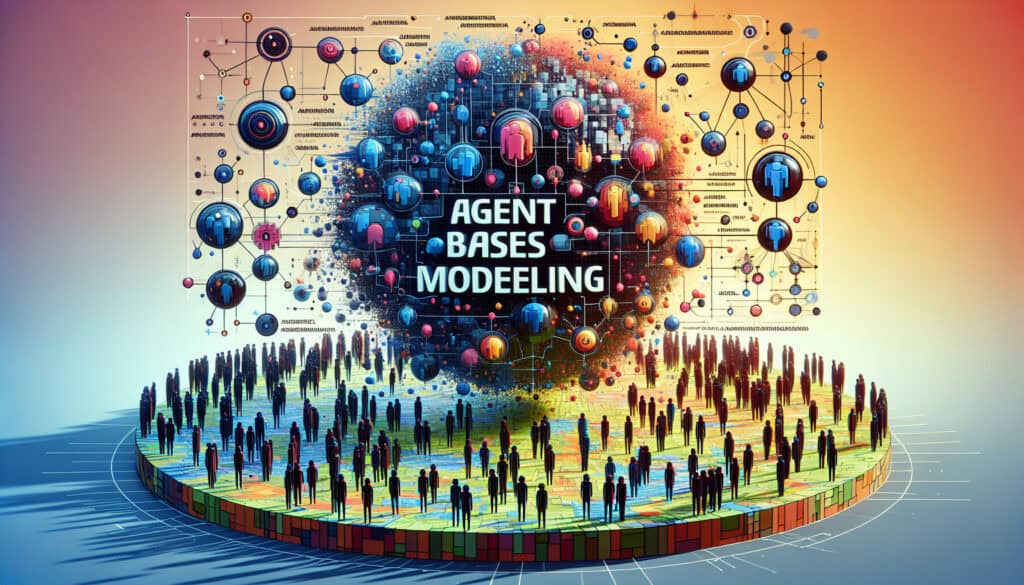تقنية النمذجة الحاسوبية التي تحاكي تصرفات وتفاعلات الوكلاء المستقلين (سواء كانت كيانات فردية أو جماعية) لتقييم آثارها على النظام ككل.
- المنهجيات: إدارة المشاريع
النمذجة المستندة إلى الوكيل

النمذجة المستندة إلى الوكيل
- الذكاء الاصطناعي (AI), التعلّم الآلي, المحاكاة, لغة نمذجة النظم (SysML)
الهدف:
كيفية استخدامه:
- في مختلف المجالات، يتم استخدامه لفهم الأنظمة المعقدة من خلال نمذجة سلوك الوكلاء الفرديين ومراقبة الأنماط والسلوكيات الناشئة للنظام.
الايجابيات
- يسمح بدراسة الأنظمة المعقدة التي يصعب تحليلها بالطرق التقليدية، ويمكنه التقاط السلوك الناشئ، ويوفر إطارًا مرنًا لنمذجة مجموعة واسعة من الظواهر.
سلبيات
- يمكن أن يكون مكلفًا من الناحية الحسابية، ويمكن أن تكون النتائج حساسة للافتراضات الموضوعة حول سلوك الوكيل، وقد يكون التحقق من صحة النموذج أمرًا صعبًا.
الفئات:
- الاقتصاد, الهندسة, حل المشكلات
الأفضل لـ
- محاكاة سلوك الأنظمة المعقدة مع العديد من العوامل المتفاعلة.
تعمل النمذجة القائمة على العوامل (ABM) كأداة قوية في مختلف المجالات، بما في ذلك العلوم البيئية والاقتصاد وعلم الاجتماع والهندسة، حيث يمكنها محاكاة وتحليل سلوك الوكلاء الفرديين بشكل فعال، مثل المستهلكين أو الحيوانات أو حتى المنتجات، داخل نظام ما. في العلوم البيئية، على سبيل المثال، يمكن للإدارة الآلية البنائية في علم البيئة أن تحاكي التفاعلات بين الأنواع المختلفة وموائلها، مما يوفر رؤى حول ديناميكيات النظام البيئي ويساعد في جهود الحفاظ على البيئة. وفي مجال الاقتصاد، يستخدم الباحثون هذه المنهجية لمحاكاة سلوكيات السوق، مما يسمح بفحص كيفية تفاعل الوكلاء الاقتصاديين مع التغيرات في السياسة أو ظروف السوق، والتي يمكن أن تسترشد بها الحكومة في قراراتها بشأن اللوائح واستراتيجيات التدخل. تنطبق هذه المنهجية أيضًا على التخطيط الحضري، حيث يمكنها محاكاة حركة وسلوك السكان داخل المدينة لتحسين تطوير البنية التحتية. خلال المراحل المختلفة لدورة حياة المشروع، يمكن دمج منهجية محاكاة حركة السكان في مراحل التصميم والاختبار، مما يسمح لأصحاب المصلحة، بما في ذلك المهندسين والمصممين والباحثين، بتصور النتائج المحتملة وتحسين ميزات المنتج وفقًا لذلك. من خلال إشراك فرق متعددة التخصصات، بما في ذلك خبراء المجال وعلماء البيانات والمستخدمين النهائيين، يمكن أن تسهل ABM التعاون حل المشكلاتمما يؤدي إلى مزيد من الفعالية و تتمحور حول المستخدم التصاميم. تتيح قابلية هذه المنهجية للتكيف إمكانية تكييفها مع أسئلة وسياقات بحثية محددة، مما يجعلها مناسبة للاستخدام في الدراسات التجريبية أو التطبيقات واسعة النطاق، اعتمادًا على أهداف المشروع وتوافر الموارد.
الخطوات الرئيسية لهذه المنهجية
- تحديد المشكلة وتحديد النظام محل الاهتمام.
- تحديد العوامل المعنية وخصائصها.
- تحديد القواعد التي تحكم سلوك الوكيل وتفاعلاته.
- إنشاء البيئة التي يعمل فيها العملاء.
- تنفيذ النموذج باستخدام البرامج أو لغات البرمجة المناسبة.
- تحديد معلمات المحاكاة وإجراء الاختبارات الأولية.
- تحليل بيانات المخرجات لتحديد الأنماط الناشئة.
- صقل النموذج بناءً على النتائج وتعديل القواعد أو المعلمات حسب الضرورة.
- إجراء المزيد من عمليات المحاكاة للتحقق من صحة النتائج واستكشاف السيناريوهات.
نصائح للمحترفين
- تنفيذ تحليل الحساسية لتحديد كيفية تأثير الاختلافات في معلمات العامل على النتائج الناشئة.
- استخدام الأنظمة متعددة العوامل مع تقنيات التعلم الآلي لتعزيز قدرات التنبؤ والتكيف.
- دمج بيانات العالم الواقعي لمعايرة النماذج بفعالية، بما يضمن التوافق مع السلوكيات والأنماط الفعلية المرصودة.
لقراءة عدة منهجيات ومقارنتها, نوصي باستخدام
> مستودع المنهجيات الشامل <
مع أكثر من 400 منهجية أخرى.
نرحب بتعليقاتكم على هذه المنهجية أو المعلومات الإضافية على قسم التعليقات أدناه ↓، وكذلك أي أفكار أو روابط متعلقة بالهندسة.
السياق التاريخي
1960
1961
1968
1974-11-15
1980
1986
1991
1960
1960
1963
1970
1980
1980
1990
1994
(إذا كان التاريخ غير معروف أو غير ذي صلة، على سبيل المثال "ميكانيكا الموائع"، يتم تقديم تقدير تقريبي لظهوره الملحوظ)














منشورات ذات صلة
استبيانات الانزعاج العضلي الهيكلي
الاختبار متعدد المتغيرات (MVT)
تحليل الانحدار المتعدد
أنظمة التقاط الحركة
طريقة MoSCoW
اختبار متوسط المزاج